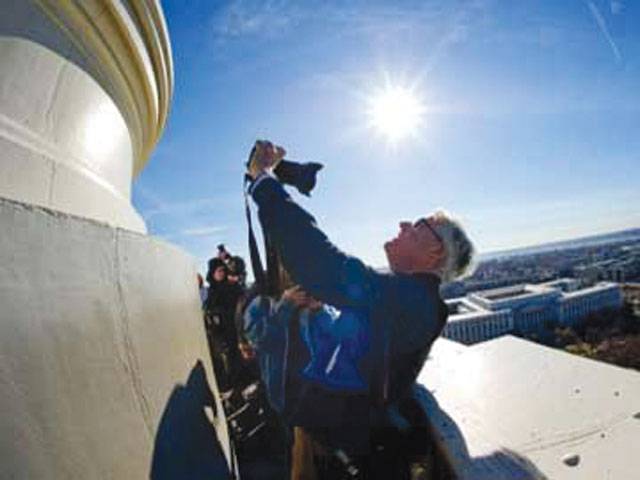WASHINGTON - Stuck on a ledge halfway up a 3,000-foot (1,000-meter) cliff in Oman, his climbing rope sliced in two by sharp rocks, Jimmy Chin did what anyone else would have done in his predicament.
“I had some time to figure out what I was going to do,” said Chin, a National Geographic photographer whose images of extreme climbing by the Straits of Hormuz appear in the magazine’s January issue.
“That’s when I took the selfie,” he told AFP. “It was one of those moments when, ‘Well, I’m a Nat Geo photographer’. I had to document (the moment). It was pretty classic.” Self-portraiture has been around for centuries, but the global proliferation of smartphones with built-in digital cameras - plus the ability to share photos instantly on social media - has taken the genre to a new level. With 2013 coming to a close, the publishers of the hallowed Oxford English Dictionary, arguably the final authority in anglophone lexicography, declared selfie to be their “word of the year.”
“Selfie: noun, informal. A photograph that one has taken of oneself, typically one taken with a smartphone or webcam and uploaded to a social media website,” according to Oxford. “Also: selfy. Plural: selfies.” Internet search provider Yahoo meanwhile estimates that in 2014, about 880 billion photographs will be taken. That’s 123 photos for every man, woman and child on Earth. Many will be selfies. In Britain, a survey for Samsung found that 17 percent of men, and 10 percent of women, take selfies because “they enjoy taking good-looking photos of themselves.”
“I think ‘selfie’ is a term of endearment for the self, in a way,” said Sarah Kennel, curator of photography at the National Gallery of Art in Washington, who admits to taking the odd selfie herself. “It does reflect a kind of narcissism in our culture,” she told AFP. US President Barack Obama and British Prime Minister David Cameron got tongues wagging when they took a selfie with Danish leader Helle Thorning Schmidt at Nelson Mandela’s memorial service in South Africa.
“What an incredible sign of the times,” children’s photographer Sarah Sloboda, author of the e-book “How to Take the Best Selfies,” told AFP. “That’s the kind of thing you can put in a time capsule to represent this period.” No one knows if Obama and friends had even heard of Selfies at Funerals, an equally controversial Tumblr compilation of, well, selfies taken at funerals, mainly by young people.
“When a teen tweets out a funeral selfie, their friends don’t castigate them,” its founder Jason Feifer explained in Britain’s Guardian newspaper. “They understand that their friend, in their own way, is expressing an emotion they may not have words for. It’s a visual language that older people - even those like me, in their 30s - simply don’t speak.” The year also saw Pope Francis in a selfie with teenagers at the Vatican, as well as pop diva Beyonce turning up in a smiling fan’s selfie in Australia, to cite a couple of Time magazine’s “11 most memorable selfies of 2013.”
From Los Angeles, gossip blogger Perez Hilton declared a pink-haired Miley Cyrus posing for herself in a skimpy Lil’ Kim Halloween costume his favorite among countless celebrity selfies over the past 12 months. But there’s no need to be famous to become famous for a selfie.
Saturday, April 20, 2024
With selfies, world turns the camera on itself

8:09 AM | April 19, 2024
ANP announces schedule of intra party elections
April 20, 2024
Dera all set to witness by-poll for NA-44 tomorrow
April 20, 2024
More rains expected in various areas of Balochistan
April 20, 2024
A Tense Neighbourhood
April 19, 2024
Dubai Underwater
April 19, 2024
X Debate Continues
April 19, 2024
Hepatitis Challenge
April 18, 2024
IMF Predictions
April 18, 2024
Kite tragedy
April 19, 2024
Discipline dilemma
April 19, 2024
Urgent plea
April 19, 2024
Justice denied
April 18, 2024
AI dilemmas unveiled
April 18, 2024
ePaper - Nawaiwaqt
Advertisement
Nawaiwaqt Group | Copyright © 2024





